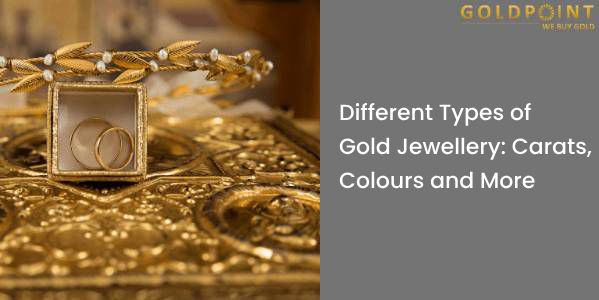
- ജൂണ്, 30 2023
- | Sell Gold
Different Types of Gold Jewellery: Carats, Colours and More
Gold has been a captivating metal for centuries with its dazzling beauty and incredible value. Today, people have several choices for gold jewellery. It is because a palette of colours and an array of carats for gold jewellery are available in the market. However, before buying or selling gold jewellery, ensure you use a gold price calculator to determine the real-time value of your ornaments.
Understanding different types of gold jewellery is crucial for customers looking to buy or sell gold. Read this post to learn about the essential aspects of various gold jewellery.
Colours of Gold Jewellery
Gold is mixed with other metals to form alloys that help to enhance its durability. Commonly used metals to create an alloy include copper, silver, zinc, palladium, and nickel. The type and quantity of other metals in gold affect its colour. It can be a greenish hue, rosy tint, or more bright yellow colour.
The three most demanding gold hues that attract customers include the following:
1. Yellow Gold
Yellow gold combines pure gold, copper, silver and sometimes zinc. This alloy helps to retain the natural colour of gold. Moreover, this combination is also the most hypoallergenic. The alloy gives a noticeable shine to the jewellery. The additional gold percentage gives the jewellery a yellowish tone (warm golden colour). Yellow gold is utilised the most in making traditional jewellery. There is no plating requirement for yellow gold. However, it needs to be cleaned over time to maintain its shine.
2. White Gold
White gold is a mix of pure gold and other white metals like nickel, palladium, zinc, or silver. Usually, an alloy contains 75% gold and about 25% nickel plus zinc. However, depending on the maker’s choice, they can adjust the percentage of metals in the alloy. It gives a cool silvery-white shade to the jewellery. White gold is well-known for engagement rings and wedding wristbands. However, it needs to be re-plated with rhodium metal over time.
3. Rose Gold
Rose gold is a mix of gold, copper and sometimes silver. Copper gives the metal a rosy-pink hue. The combination of metals impacts the properties of the final gold mix. Silver adds brightness and reduces the colour intensity of the metal. The manufacturer can change the percentage of gold, copper, and silver for the desired rosy hue. The higher the copper percentage in the alloy, the more rosy hue is elevated.
Customers can sell their old gold jewellery with trustworthy gold buyers offering fair prices based on the real-time market value of gold.
Different Carats of Gold
The proportion of gold in the alloy is measured in carats. Pure gold does not have durability or hardness to make jewellery. Therefore, mixing it with other metals is inevitable. It makes gold wearable and durable. This mixing results in different gold carat levels. The lower the carat in jewellery, the less expensive it is. Simply because it contains less part of gold. A carat is 1/24 part of pure gold. The purity of gold alloy is measured based on the number of these parts.
Let us understand the carat weight defining gold purity.
1. What is 14-Carat Gold?
14-carat gold is the most wearable type of gold because it has 14 parts gold (58.3%) and ten parts alloys (41.7%).
2. What is 18-Carat Gold?
18-carat gold has 18 parts gold (75%) and six parts alloys (25%).
3. What is 24-Carat Gold?
24 carats means the purest form of gold without alloys. It is 99.9% gold.
Renowned gold-buying companies use technology to clean and measure the old gold purity and provide the best value for each part of your gold. Before approaching one, you can use a gold price calculator to ensure you receive a fair price based on the current market value of gold.
Types of Gold Jewellery
1. Gold Plated
The base metal of the gold-plated jewellery can be brass or copper. It is plated with a thin layer of gold, typically 0.05% or less gold. It is the least-priced gold jewellery but needs to be re-plated over time.
2. Gold-Filled
A layer of solid gold is bonded with a base metal (brass or copper) through heat and pressure to make gold-filled jewellery. It is more durable with a much thicker gold layer as compared to gold-plated jewellery. It contains a minimum of 5% gold.
3. Gold Vermeil
An electroplating process is used to make this jewellery. This type of jewellery is made of a sterling silver base covered in thick gold plating that includes 2.5 microns of gold.
4. Solid Gold
Solid gold refers to jewellery made of gold without a base metal that comes in various carats. The higher the carat, the higher the quality, purity and price.
Conclusion
Thus, whether customers are looking for a trendy accessory or a traditional piece, they have several gold jewellery options to choose from.
However, before buying or selling gold jewellery, ensure you approach a reputed gold buyer. They use the latest technology to determine the actual value of your gold ornaments.










